Site LP109
Back to Bet Bet Creek Catchment Homepage
Groups: Timor West Landcare Group
Aust. Soil Class.: Lithocalcic, Subnatric, Red SODOSOL
Great Soil Group: solodic
General Site Description: Terrace near Emu Creek.
Geology: Quaternary alluvial deposits (Shepparton Formation).
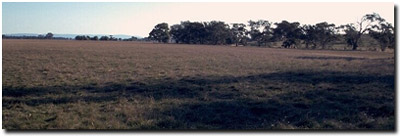 Site LP109 Soil Landscape |
Soil Profile Morphology:
| Surface Soil | 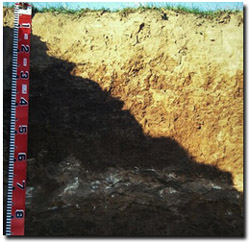 Site LP109 Soil Profile | ||
| A1 | 0-7 cm | Dark brown (7.5YR3/4); fine sandy clay loam; very firm consistence (moderately moist); 10% pores; pH 5.9; clear change to: | |
| A2 | 7-25 cm | Dark brown (7.5YR3/4); fine sandy clay loam; strong consistence (moderately moist); 5% pores; pH 6.6; sharp change to: | |
| Subsoil | |||
| B21 | 25-60 cm | Dark reddish brown (5YR3/3); medium clay; moderate coarse blocky structure; weak consistence (moist); pH 8.5; sharp change to: | |
| B2m | 60-75 cm | Calcrete; roots stop at 60 cm; sharp change to: | |
| D1 | 75-100 cm | Strong brown (7.5YR4/6); sandy clay loam; moderate coarse polyhedral structure; firm consistence (moist); pH 9.4 gradual change to: | |
| D2 | 100-120 cm | Strong brown (7.5YR4/6) with many (20%) brown (7.5YR5/2) mottles; sandy loam (heavy); some clay tubules; very firm consistence (moist); gradual change to: | |
| D3 | 120-140 cm | Strong brown (7.5YR4/6); light sandy clay loam; firm consistence (moist). | |
Key Profile Features:
- Strong texture contrast between surface (A) horizons and the upper subsoil (B21) horizon.
- Calcrete layer at 60 cm.
pH | Salinity Rating | |||
Surface (A1 horizon) | Moderately acid | Very low | Non-Sodic | None |
Subsoil (B21 horizon) | Moderately alkaline | Very low | Sodic | Strong-Complete |
Deeper subsoil (at 75+100 cm) | Very strongly alkaline | Very low | _ | _ |
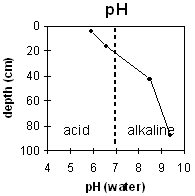 | 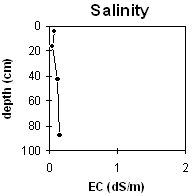 | 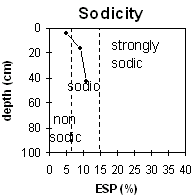 |
Horizon | Horizon Depth | pH (water) | pH CaCl2 | EC dS/m | NaCl % | Exchangeable Cations | Ex Al mg/kg | Ex Ac meq/100g | Field pF2.5 | Wilting Point pF4.2 | Coarse Sand (0.2-2.0mm) | Fine Sand (0.02-0.2mm) | Silt (0.002-0.02mm) | Clay (<0.002mm) | |||
Ca | Mg | K | Na | ||||||||||||||
meq/100g | |||||||||||||||||
A1 | 0-7 | 5.9 | 4.8 | 0.08 | 2.9 | 2 | 0.77 | 0.37 | 7 | 8.2 | 26.2 | 3 | 45 | 34 | 17 | ||
A2 | 7-25 | 6.6 | 5 | 0.04 | 1.7 | 2.4 | 0.41 | 0.41 | 9 | 7.7 | 21.2 | ||||||
B21 | 25-60 | 8.5 | 7 | 0.12 | 3.2 | 12 | 0.89 | 2 | 11 | 17.7 | 33.2 | 1 | 19 | 28 | 58 | ||
B2m | 75-100 | 9.4 | 8.2 | 0.15 | |||||||||||||
Management Considerations:
Whole Profile
- Management strategies for all soils should aim to increase organic matter levels in the surface soil; minimise the degradation of soil aggregates and porosity; promote the development of stable biopores; improve the calcium status of the cation complex (when sodium is a significant part – i.e. sodic) and break up any hardpans. Less frequent tillage, using less aggressive implements, and working the soil at optimum moisture contents can all assist in maintaining soil aggregation and porosity as well as reducing the breakdown of organic matter.
- Plant available water capacity (PAWC) is estimated to be low (estimated at 70 mm) for the top 60 cm of the soil profile. This is based on the available laboratory data. It is assumed that rooting depth will be restricted by the calcrete zone at 60 cm.
- The level of the organic carbon indicates that the organic matter of the shallow surface soil is low. Organic matter is important for reducing slaking and enhancing soil aggregation, fertility and water holding capacity for soils such as this with high fine sand (45%) and silt (33%) content. Organic matter levels will build up under pasture but will decline if cultivation takes place. Practices such as residue retention, minimum tillage and including pasture rotations should be utilised if cropping occurs.
- The surface horizons have a low inherent fertility (based on the sum of the basic exchangeable cations). Organic matter will be important for enhancing fertility.
- Levels of exchangeable magnesium are high (65%) in the subsoil. In some soils this may induce potassium deficiency (Baker and Eldershaw, 1993).
- The dense and coarsely structured subsoil is sodic and slightly dispersive (with a low calcium to magnesium ratio (<1)) to 60 cm. This will result in restricted root and water movement in the subsoil. Water is likely to accumulate on the top of the subsoil after heavy rains causing waterlogging of the subsurface horizons.
- The calcrete layer at 60 cm is also likely impede water and root movement down the profile.


